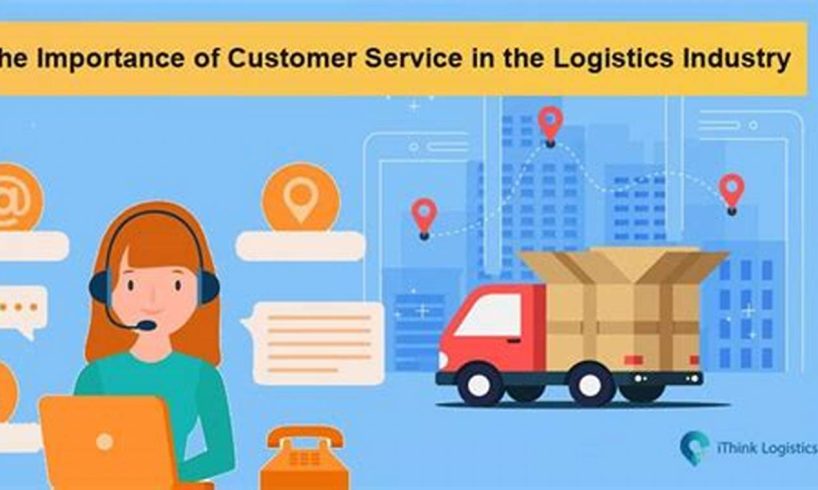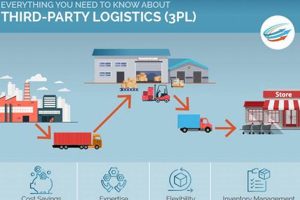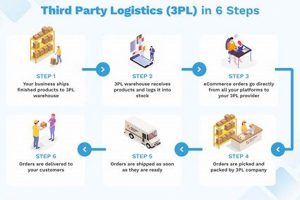
Customer service logistics encompasses the processes and systems used to manage and deliver customer service efficiently and effectively. It involves planning, organizing, and controlling the resources, activities, and information required to provide excellent customer service. For instance, customer service logistics may include managing customer inquiries, resolving complaints, providing technical support, and tracking customer interactions.
Effective customer service logistics is crucial for businesses to achieve high levels of customer satisfaction, loyalty, and retention. It helps businesses optimize their resources, improve operational efficiency, and gain a competitive advantage. Moreover, it provides valuable insights into customer behavior, preferences, and feedback, which can inform product development, marketing strategies, and overall business decisions.
The field of customer service logistics has evolved over time, driven by technological advancements and changing customer expectations. In the past, customer service was primarily conducted through phone calls and emails. Today, businesses use a variety of channels, including social media, live chat, and self-service portals, to interact with customers. As a result, customer service logistics has become more complex and requires a comprehensive approach to managing multiple channels and touchpoints.
1. Planning
Planning is a crucial aspect of customer service logistics, as it sets the foundation for efficient and effective customer service operations. It involves anticipating customer needs, forecasting demand, and allocating resources accordingly. Effective planning enables businesses to prepare for various scenarios and respond promptly to customer inquiries and requests.
One key element of planning in customer service logistics is capacity planning. This involves determining the number of customer service representatives, channels, and resources required to meet anticipated demand. Accurate capacity planning helps businesses avoid bottlenecks and ensure that customers receive timely assistance. For instance, during peak seasons or when launching new products, businesses may need to scale up their customer service operations by hiring additional staff or implementing self-service options.
Planning also involves establishing service level agreements (SLAs) to define the expected quality and responsiveness of customer service. SLAs set clear targets for metrics such as response time, resolution time, and customer satisfaction. By adhering to SLAs, businesses can manage customer expectations and ensure that they are met or exceeded.
Effective planning in customer service logistics requires collaboration between different departments, including customer service, operations, and IT. This cross-functional approach ensures that all aspects of customer service are aligned and that resources are allocated efficiently. Regular review and adjustment of plans are also essential to adapt to changing customer needs and business objectives.
In summary, planning is a critical component of customer service logistics, enabling businesses to anticipate customer needs, allocate resources effectively, and establish clear service level agreements. By investing in robust planning processes, businesses can lay the foundation for high-quality customer service that meets the expectations of their customers.
2. Organization
Within the realm of customer service logistics, organization plays a pivotal role in ensuring efficient and effective operations. It encompasses the structuring of resources, activities, and information to facilitate seamless customer service delivery. A well-organized customer service function enables businesses to respond promptly to customer inquiries, resolve issues swiftly, and deliver a consistent and high-quality customer experience.
One key aspect of organization in customer service logistics is the establishment of clear roles and responsibilities. Each customer service representative should have a defined set of tasks and responsibilities to avoid confusion and duplication of effort. This clarity ensures that customers are directed to the appropriate person or department for assistance, reducing resolution times and improving customer satisfaction.
Another important aspect of organization is the implementation of efficient workflows and processes. These workflows should outline the steps involved in handling customer inquiries and resolving issues, ensuring that each case is handled consistently and effectively. Standardized processes help reduce errors, improve efficiency, and provide a consistent experience for customers.
Effective organization in customer service logistics also involves the use of appropriate technology and tools. A customer relationship management (CRM) system, for example, can help businesses manage customer interactions, track customer history, and provide a comprehensive view of each customer’s needs. By leveraging technology, businesses can streamline their customer service operations, improve collaboration, and gain valuable insights into customer behavior.
In summary, organization is a fundamental aspect of customer service logistics, enabling businesses to structure their resources, activities, and information for optimal performance. Through clear roles and responsibilities, efficient workflows, and the use of technology, businesses can enhance their customer service delivery, increase customer satisfaction, and achieve their business objectives.
3. Control
Control is an essential aspect of customer service logistics, as it ensures that customer service operations are running smoothly, efficiently, and in accordance with established standards and objectives. It involves monitoring performance, identifying areas for improvement, and taking corrective actions to maintain and enhance the quality of customer service.
One key element of control in customer service logistics is performance monitoring. This involves tracking and measuring key performance indicators (KPIs) such as response time, resolution time, customer satisfaction, and first-contact resolution rate. By monitoring these metrics, businesses can identify areas where they are excelling and areas where they need to improve.
Another important aspect of control is quality assurance. This involves establishing and maintaining standards for customer service interactions. Quality assurance processes may include mystery shopping, customer surveys, and peer reviews. By regularly assessing the quality of customer service, businesses can identify and address any gaps or weaknesses, ensuring that customers receive a consistently high level of service.
Effective control in customer service logistics also requires continuous improvement. This involves regularly reviewing and updating processes, systems, and training programs to identify and implement improvements. By embracing a culture of continuous improvement, businesses can stay ahead of the curve and adapt to changing customer needs and expectations.
In summary, control is a critical component of customer service logistics, enabling businesses to monitor performance, ensure quality, and drive continuous improvement. By implementing effective control mechanisms, businesses can ensure that their customer service operations are running at peak efficiency and delivering a consistently high level of customer satisfaction.
4. Resources
Within the realm of customer service logistics, resources play a fundamental role in enabling businesses to deliver high-quality customer service. Resources encompass the people, technology, and infrastructure required to manage and execute customer service operations effectively.
- Human Resources: Customer service representatives are the frontline of customer service, responsible for interacting with customers, resolving inquiries, and building relationships. Skilled and experienced customer service representatives are essential for providing a positive and efficient customer experience.
- Technology: Technology plays a crucial role in streamlining customer service operations, improving efficiency, and enhancing the customer experience. Customer relationship management (CRM) systems, help desks, and self-service portals are examples of technology resources that can improve customer service delivery.
- Infrastructure: The physical and digital infrastructure of a business also impacts customer service logistics. Adequate office space, reliable communication systems, and secure data storage are essential for providing uninterrupted and secure customer service.
- Financial Resources: Financial resources are necessary to acquire and maintain the necessary resources for customer service operations. This includes investments in training, technology, and infrastructure to ensure that customer service can operate effectively and efficiently.
By optimizing the allocation and utilization of resources, businesses can enhance their customer service logistics, improve customer satisfaction, and achieve their business objectives.
5. Activities
Within the realm of customer service logistics, the diverse range of activities encompasses the specific tasks and processes involved in delivering efficient and effective customer service. These activities are interconnected and interdependent, working together to ensure that customer inquiries are handled promptly and professionally, leading to high levels of customer satisfaction.
- Managing Customer Interactions: This activity involves handling customer inquiries through various channels such as phone, email, live chat, and social media. It requires active listening, empathy, and strong communication skills to understand and address customer concerns effectively.
- Resolving Customer Issues: Customer service representatives analyze customer issues, investigate root causes, and work towards finding appropriate solutions. This may involve troubleshooting technical problems, processing refunds or exchanges, or escalating complex issues to the relevant department.
- Providing Product/Service Information: Customer service representatives serve as a valuable source of information about a company’s products or services. They provide accurate and detailed explanations, answer customer queries, and offer guidance to help customers make informed decisions.
- Building Customer Relationships: Customer service activities extend beyond resolving issues to building long-lasting relationships with customers. Representatives strive to create a positive and personalized experience, fostering customer loyalty and encouraging repeat business.
These activities are crucial for maintaining a high level of customer service logistics. By effectively managing customer interactions, resolving issues promptly, providing accurate information, and building strong relationships, businesses can enhance customer satisfaction, strengthen their brand reputation, and drive business growth.
6. Information
In the realm of customer service logistics, information plays a pivotal role in enabling businesses to deliver efficient, effective, and personalized customer service. It encompasses the collection, organization, and dissemination of data and knowledge that is essential for customer service representatives to perform their duties and meet customer needs effectively.
The importance of information in customer service logistics can be attributed to several factors. Firstly, it empowers customer service representatives with the necessary knowledge to understand customer inquiries and provide accurate and timely responses. Comprehensive product or service information, customer history, and relevant policies and procedures are crucial for resolving customer issues promptly and efficiently.
Secondly, effective use of information enables businesses to personalize the customer experience. By leveraging customer data, such as purchase history, preferences, and communication channels, customer service representatives can tailor their interactions to meet individual customer needs. This personalized approach enhances customer satisfaction and strengthens customer relationships.
Furthermore, information plays a vital role in continuous improvement and innovation within customer service logistics. By analyzing customer feedback, identifying trends, and measuring key performance indicators, businesses can gain valuable insights into customer behavior and preferences. This information can be used to optimize processes, improve training programs, and develop new products or services that better meet customer needs.
In conclusion, information is a fundamental component of customer service logistics, enabling businesses to deliver high-quality customer service, build strong customer relationships, and drive business growth. By investing in effective information management and leveraging data-driven insights, businesses can stay ahead of the curve and meet the evolving expectations of their customers.
7. Optimization
In the realm of customer service logistics, optimization encompasses the ongoing process of refining and improving customer service operations to enhance efficiency, effectiveness, and customer satisfaction. It involves the strategic allocation of resources, implementation of best practices, and leveraging technology to streamline processes and maximize outcomes.
- Process Optimization:
Process optimization involves analyzing and improving customer service workflows to eliminate bottlenecks, reduce wait times, and enhance overall efficiency. This can include implementing automated systems, streamlining communication channels, and empowering customer service representatives with self-service tools. - Resource Optimization:
Resource optimization focuses on efficiently allocating and utilizing human resources, technology, and infrastructure to meet customer demands while minimizing costs. This may involve workforce scheduling, skills training, and strategic investment in technology to improve productivity. - Performance Optimization:
Performance optimization involves monitoring and measuring key performance indicators (KPIs) such as response time, resolution rate, and customer satisfaction to identify areas for improvement. This data-driven approach enables businesses to continuously refine their customer service operations and set targets for excellence. - Customer Experience Optimization:
Customer experience optimization prioritizes enhancing the overall customer experience by understanding customer needs, preferences, and feedback. This may involve personalizing interactions, offering proactive support, and creating a seamless and consistent experience across all touchpoints.
Optimization in customer service logistics is an iterative process that requires ongoing evaluation, adjustment, and a commitment to continuous improvement. By embracing optimization principles, businesses can enhance customer satisfaction, increase operational efficiency, and drive business growth.
8. Customer Satisfaction
Customer satisfaction is a cornerstone of customer service logistics. Satisfied customers are more likely to return for repeat business, recommend a company’s products or services to others, and provide positive feedback. Conversely, dissatisfied customers can damage a company’s reputation, reduce sales, and increase customer churn. Therefore, it is essential for businesses to prioritize customer satisfaction in all aspects of their customer service logistics.
There are many factors that contribute to customer satisfaction, including the speed and efficiency of service, the helpfulness and friendliness of customer service representatives, and the overall experience of interacting with a company. Customer service logistics plays a vital role in ensuring that all of these factors are met.
For example, if a customer has a question about a product or service, they want to be able to get an answer quickly and easily. A well-organized customer service department with efficient processes and knowledgeable representatives can provide this type of service. Additionally, if a customer has a problem with a product or service, they want to be able to get it resolved quickly and easily. A customer service department that is empowered to make decisions and take action can provide this type of service.
In today’s competitive business environment, customer satisfaction is more important than ever. By focusing on customer service logistics, businesses can improve customer satisfaction, increase sales, and build lasting relationships with their customers.
9. Business Objectives
In the realm of business, objectives serve as the guiding force, shaping strategies and directing operations towards desired outcomes. Customer service logistics, as a critical aspect of business operations, plays a pivotal role in achieving these objectives.
- Customer Retention and Loyalty:
Satisfied customers are the backbone of any successful business. Customer service logistics, by ensuring efficient and positive customer interactions, fosters customer loyalty and retention. Proactive support, personalized experiences, and timely issue resolution contribute to building strong customer relationships, leading to repeat business and increased customer lifetime value. - Revenue Generation and Growth:
Excellent customer service is not just a cost center but a revenue generator. By resolving customer issues promptly and effectively, businesses can minimize customer churn and increase customer satisfaction, which directly impacts revenue and profitability. Additionally, upselling and cross-selling opportunities during customer interactions can further drive revenue growth. - Reputation Management and Brand Building:
In today’s digital age, customer experiences are shared rapidly on social media and review platforms. Effective customer service logistics helps businesses maintain a positive brand reputation by addressing customer concerns promptly and professionally. Positive customer feedback and testimonials enhance brand credibility and attract new customers. - Competitive Advantage and Differentiation:
In a competitive market, providing exceptional customer service can set a business apart from its competitors. By investing in customer service logistics, businesses can differentiate themselves and gain a competitive advantage. Efficient and personalized customer support can create a lasting impression, leading to increased customer preference and market share.
In conclusion, customer service logistics is inextricably linked to business objectives. By prioritizing customer satisfaction, businesses can drive revenue growth, enhance brand reputation, gain a competitive advantage, and ultimately achieve their overall business goals.
Frequently Asked Questions about Customer Service Logistics
This section addresses frequently asked questions to provide a comprehensive understanding of customer service logistics and its significance in business operations.
Question 1: What is the significance of customer service logistics in business?
Answer: Customer service logistics plays a vital role in achieving business objectives, including customer retention, revenue generation, reputation management, and competitive advantage. By prioritizing customer satisfaction, businesses can foster loyalty, drive growth, enhance their brand image, and differentiate themselves in the market.
Question 2: How does customer service logistics contribute to customer retention and loyalty?
Answer: Effective customer service logistics ensures efficient and positive customer interactions, leading to customer satisfaction and loyalty. Proactive support, personalized experiences, and timely issue resolution build strong customer relationships, encouraging repeat business and increasing customer lifetime value.
Question 3: How can customer service logistics impact revenue generation and growth?
Answer: Excellent customer service is not just a cost center but a revenue generator. By resolving customer issues promptly and effectively, businesses can minimize customer churn and increase customer satisfaction, which directly impacts revenue and profitability. Additionally, upselling and cross-selling opportunities during customer interactions can further drive revenue growth.
Question 4: How does customer service logistics contribute to reputation management and brand building?
Answer: In today’s digital age, customer experiences are shared rapidly on social media and review platforms. Effective customer service logistics helps businesses maintain a positive brand reputation by addressing customer concerns promptly and professionally. Positive customer feedback and testimonials enhance brand credibility and attract new customers.
Question 5: In what ways can customer service logistics provide a competitive advantage and differentiation?
Answer: In a competitive market, providing exceptional customer service can set a business apart from its competitors. By investing in customer service logistics, businesses can differentiate themselves and gain a competitive advantage. Efficient and personalized customer support can create a lasting impression, leading to increased customer preference and market share.
Question 6: What are some key strategies for improving customer service logistics?
Answer: Effective customer service logistics requires a combination of strategies, including: planning and organization, efficient resource allocation, continuous improvement through performance monitoring, leveraging technology for automation and data analysis, and fostering a customer-centric culture throughout the organization.
In conclusion, customer service logistics is a critical aspect of business operations that plays a significant role in achieving business objectives. By implementing effective customer service logistics strategies, businesses can enhance customer satisfaction, drive growth, build a strong brand reputation, and gain a competitive advantage.
Moving forward, the article will delve into the specific components and best practices of customer service logistics to provide a comprehensive understanding of its implementation and impact on business success.
Customer Service Logistics Tips
Effective customer service logistics is crucial for businesses to achieve high levels of customer satisfaction, loyalty, and retention. Here are some tips for optimizing your customer service logistics:
Tip 1: Establish Clear Processes and Procedures
Well-defined processes and procedures ensure that customer inquiries are handled consistently and efficiently. This includes establishing clear roles and responsibilities, setting service level agreements, and documenting workflows.
Tip 2: Leverage Technology for Efficiency
Technology can streamline customer service operations and improve efficiency. Consider implementing a customer relationship management (CRM) system, live chat software, and self-service portals to automate tasks and provide faster support.
Tip 3: Train and Empower Your Team
Well-trained and empowered customer service representatives are essential for providing excellent service. Invest in comprehensive training programs and empower your team to make decisions and resolve customer issues promptly.
Tip 4: Track and Monitor Performance
Regularly track and monitor key performance indicators (KPIs) such as response time, resolution rate, and customer satisfaction. This data will help you identify areas for improvement and make data-driven decisions.
Tip 5: Foster a Customer-Centric Culture
A customer-centric culture emphasizes understanding and meeting customer needs. Encourage empathy, active listening, and a willingness to go the extra mile for customers throughout your organization.
Tip 6: Personalize the Customer Experience
Personalizing the customer experience can enhance satisfaction and loyalty. Use customer data to tailor interactions, offer relevant recommendations, and build stronger relationships with your customers.
Tip 7: Continuously Improve and Innovate
Customer service logistics is an ever-evolving field. Stay up-to-date on industry best practices, emerging technologies, and customer trends to continuously improve and innovate your service delivery.
By implementing these tips, businesses can optimize their customer service logistics, enhance customer satisfaction, and drive business growth.
Conclusion
In conclusion, customer service logistics plays a pivotal role in shaping the customer experience and driving business success. By effectively managing resources, optimizing processes, and leveraging technology, businesses can deliver exceptional customer service that fosters satisfaction, loyalty, and growth.
Organizations that prioritize customer service logistics gain a competitive advantage by differentiating themselves in the marketplace, building strong customer relationships, and generating positive brand. As technology continues to advance and customer expectations evolve, businesses must remain agile and innovative in their approach to customer service logistics to stay ahead of the curve and meet the ever-changing needs of their customers.






